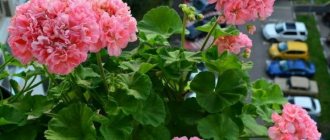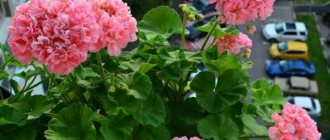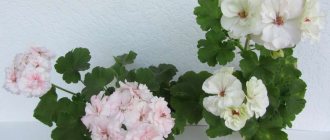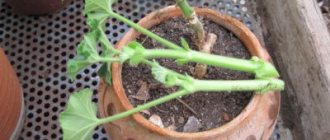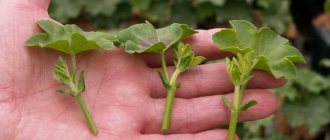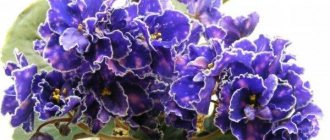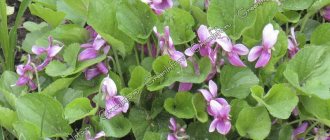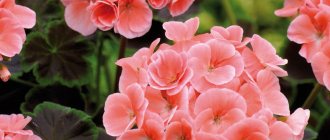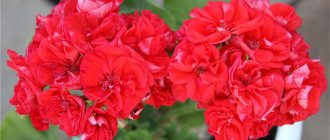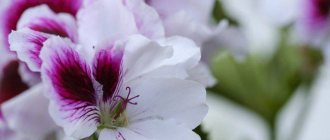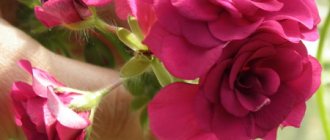Terry geranium - what kind of pelargonium is it?
Terry geranium (pelargonium) belongs to the Geraniaceae family. About 500 species of this plant are known. Today, breeders have bred geraniums in almost all colors of the rainbow and all kinds of shades.
This flower is native to South Africa. It was first bred in 1631 by an English botanist and was initially called geranium. Much later, in 1789, the current name appeared.
Terry geranium is a zonal variety of pelargonium. Large spherical inflorescences, resembling roses in appearance, are located on the upper branches of the plant. This species appeared in the middle of the 19th century.
For your information! Pelargonium terry is not related to the genus Geranium.
Features of the flower
Terry geranium with roses contains several corollas, each of which contains more than 8 petals. On a tall, thick, strong stem there are round leaves with wavy edges. In many geraniums, the edges of green leaves are framed by a thin rim of burgundy or purple. There are rare varieties with black, golden, bronze and purple leaves.
The diversity of species and varieties of Geraniaceae Pelargonium depends on changes in its genome. Sometimes this happens spontaneously. If a flower of a certain variety turns out to be different from the sample, then in such cases they say that pelargonium has acquired a sport. The shape and color of petals, leaves, stem size, density of inflorescences and much more change.
Note! Pelargonium purifies the air, drives away pests from neighboring plants, and repels mosquitoes.
Pelargonium pebbles
Photo competition “The most beautiful pelargonium”
Dear site visitors! I invite you to take part in a photo competition for the most beautiful pelargonium.
Conditions for participation in the competition
Any registered user of the leto.tomsk.ru website can take part in the competition, regardless of place of residence. But if a contestant who does not live in Tomsk or Seversk wins, he himself will organize and pay for the delivery of the prize (for our part, we promise to facilitate this to the best of our ability).
Photos of pelargoniums belonging to the competition participant and taken in 2010 are accepted for participation in the competition. The variety of pelargoniums entered into the competition does not matter at all - they can be either varietal or “grandmother’s” or grown from seeds.
No distinctions will be made between groups of pelargoniums. The competition is common to all - royal, angelic, zonal, ivy-leaved, fragrant, etc.
No more than 4 different varieties of pelargonium species are accepted from one participant. One pelargonium - 2 photos. The first photo is the most advantageous view of pelargonium WITH A POT; the second photo is a view of the plant from TOP, so that you can evaluate the symmetry of the bush.
Dates
The competition will be held from 01.08.10 to 01.09.10
.
During this time, participants will post photos on our website in a specially created topic.
From 02.09.10 to 15.09.10
As a result of voting by all interested registered users of the site, the winner and prize-winners of the competition will be determined.
We make an announcement about the competition in advance so that everyone who wants to participate can form bushes for the competition and prepare them for the most abundant flowering.
Nominations and prizes
1st place - the most correctly formed and abundantly flowering pelargonium bush. Prize - 2 rooted cuttings of varietal pelargoniums from the Ego collection of the winner's choice.
2nd place. The prize is a rooted cutting of zonal pelargonium Apple Blossom Rosebud.
3rd place. The prize is a rooted cutting of zonal pelargonium Deacon Orangeade.
A separate nomination is “The most unusual pelargonium” (the original form of the specimen is “snag”, bonsai, etc.). The prize is a rooted cutting of pelargonium from the Unicum Urchin group (from Solaris).
Special nomination “The most unusual pelargonium”
Only one winner. Up to three photos of one plant are accepted to best reflect all the features of pelargonium.
Photo requirements
Photo resolution is at least 800x600 pixels.
Criteria for evaluating contestants' pelargoniums
The most symmetrical, fluffy pelargonium bush at the peak of flowering.
In the category “The most unusual pelargonium” - the originality of the appearance of pelargonium as a whole. Here, on the contrary, standard beauty is not welcome.
All questions about the competition can be asked here - Attention! Contest!.
Competition results
Voting for the best pelargonium is completed, the winners have been determined. 1st place was awarded to the owner of the best pelargonium Apple Blossom Rosebud - Vine. 2nd place was taken by the royal pelargonium F4, 3rd place was shared by two pelargoniums: Richard Hodgson (Tatu 911) and Pebbles (Jane).
There were no nominees as such in the category “The Most Unusual Pelargonium” and, after consultation, it was decided to award the prize to Bakissa (red pelargonium).
We congratulate the winners and wish all participants further success in growing these beautiful plants and new varieties (where would we be without them!).
All winners, in addition to previously announced prizes, will be awarded Diplomas.
When using materials of our website the active link to the site is required.
The best varieties of terry pelargonium for growing at home
There are many different varieties of terry geraniums, which gardeners are happy to grow in rooms, gardens, flower beds, and summer cottages. In their descriptions, a lot of attention is paid to the color of the petals and the size of the bush.
Pelargonium Pebbles
Pelargonium Pebbles has crimson flowers with a white center. The back of the petals is white. The plant is very small, so it does not require abundant watering. It bushes actively and does not need to be shaped. The lower leaves never dry out. In bright light, a dark green spot appears in the middle of the leaf.
Pelargonium Mimi
Miniature pelargonium Mimi is distinguished by its pink-fawn petals. It actively blooms and grows; it is not necessary to form it. You can prune the branches a little to make the bush compact. Pelargonium Mimi is ideal for a greenhouse, room, flower bed.
Pelargonium Mallorca
Incredibly beautiful, bright Mallorca pelargonium is characterized by its small height. Its petals are painted in 2 colors: white and pink, sometimes red. Pelargonium Mallorca grows quickly and spreads widely, so its branches need to be periodically pruned.
Note! This variety should not be confused with the Majorca variety, which is topped with pale pink or white flowers. Mallorca is a zonal species, while Mallorca pelargonium is a cactus species.
Pelargonium Saxdalens Selma
Pink flight flowers on a small bush are a distinctive feature of Selma pelargonium. The back side of the petal is slightly lighter. The flowers form very large and dense inflorescences, so the plant looks like a rose. Selma is a zonal pelargonium. It will decorate any flower bed, garden or room. Due to its external resemblance to a rose, the flower looks luxurious.
Silk Moira
The light apricot shade of the petals is the pride of the Shelk Moira variety. A light green circle is visible in the center of each leaf. A miniature bush with a dense inflorescence looks elegant and resembles a bouquet of roses.
Brookside Fantasy
A very small bush with lilac or soft pink flowers suitable for growing in pots on a windowsill. The leaves have an unusual color: in the center and along the edges they are light green, and in the center there is a ring of a darker shade.
Bold Carmine
Bright red, crimson, burgundy flowers are a distinctive feature of the Bold Carmine variety. They bloom actively, abundantly, luxuriantly, and bush quickly. This is one of the most profusely flowering varieties.
Geranium Majesta
Majesta is a pelargonium with bright, juicy petals of a reddish-purple color. Lush, dense inflorescences decorate a low bush that branches and grows well.
Ludwigsburger Flair
The light pink and white flowers of Ludwigsburger Flair look charming. There is a green core in the center. The reverse side of the petal is white or very light. The peculiarity of this variety is that it does not tolerate dry air, low temperatures and open solar radiation. It needs a little shade.
Lara Harmony
Pink or crimson flowers make Lara Harmony look like rose bushes. The inflorescences are thick and dense, the bush is actively growing. The plant requires careful treatment and good care.
White terry geranium is a favorite of many gardeners. She looks tender, pure, defenseless. This plant blooms from March to November, actively grows and branches. You can choose the following types of white pelargonium:
- Ise Rose;
- Jacky Gauld;
- Joan of Arc;
- PAC Blanche Roche;
- PAC Viva Carolina.
Geranium Himalayan Plenum belongs to the Geranium family, but is also a double flower. Its lush purple petals form large inflorescences on a tall bush. This plant can be grown in the garden or flower bed.
For your information! The name Pelargonium means “stork” in ancient Greek. The plant was named so because the shape of the petals and seed pod resembled the beak of a stork.
Pelargonium pebbles
The variety is currently not in the collection.
Terry miniature pelargonium.
The variety has been familiar to everyone for a long time, and has managed to win many hearts! The bush is formed perfectly, fluffy, small, and overwinters well. Funny, interesting flowers. Everything you need for beauty and comfort at home.
